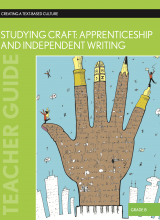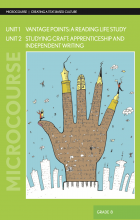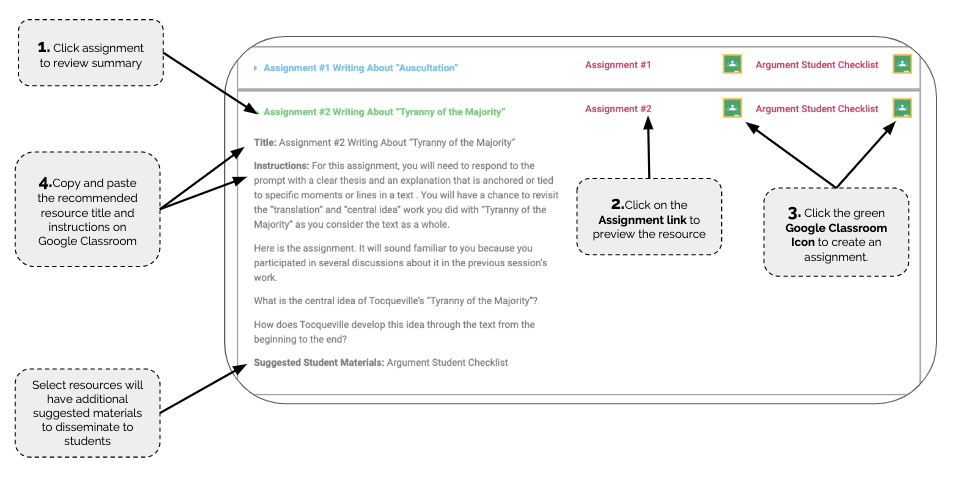Studying Craft: Apprenticeship and Independent
Writing - Grade 8
Writing - Grade 8
Studying Craft: Apprenticeship and Independent Writing is a two-part unit designed to both launch and then periodically assess students’ independent writing work.


Table of Contents
Writing Tasks
Title: Favorite Author Study Proposal
Teacher Manual Instructions:
Session 2
Reconvene the class and ask students to share the results of their work on the short assignments.
Distribute copies of the “Favorite Writer Study Proposal” form to each student.
Review the contents of the form and answer any questions students have about the author study work at this time.
Wrap up the session by negotiating a deadline for submitting the “Favorite Author Study Proposal.”
Title: Intra-Book Study
Teacher Manual Instructions:
Session 5
After the list is “completed” (actually, the list should be deemed “a work in progress,” as new items can and should be added as needed), introduce the “Intra-Book Study” form to students.
Give students any remaining time to revise their “short assignments” lists and to continue work on those items.
Reiterate the deadline for the author study proposal.
Give students this work period to complete those tasks.
Confer with students about this work during this time.
Title: Independent Writing Project Proposal
Teacher Manual Instructions:
Session 9
Review each section of the form with the class.
Answer any questions students have about the contents.
Explain to the class that each student will be required to complete one to three independent writing project drafts in addition to the work set out
in upcoming units. Of these drafts, at least one should be submitted for publication. Tell students that items related to publication will be addressed in Sessions 12 and 13.
Title: Independent Writing Project Commentary
Teacher Manual Instructions:
Session 10
Explain to the class that this form gives students an opportunity to explain how they worked during each independent writing project. It is a place where students can explain what they did, what they were trying to do, what resources they used, what they like about their project, what they learned, and what problems they faced.
Review the contents of the commentary form with the class and answer any questions students might have.
Title: Periodical Profile
Teacher Manual Instructions:
Session 12
Review the form with the class and then use the rest of the focus lesson to model how to complete the form. Be sure to focus your demonstration on one of the periodicals listed on the “Periodicals That Publish Student Writing.”
Title: Setting Goals for Independent Writing
Teacher Manual Instructions:
Session 15
Title: Author Study Score Sheet
Teacher Manual Instructions:
Session 16
Be sure the score sheet you distribute matches the contract you negotiated with your students. You may need to make some adjustments.
Review the score sheet with the class and show students how to use the score sheet and the “Author Study Contract” to review and rate their author study work.
Give students time to complete the score sheet.
Afterwards, ask students to turn in their author study work and to attach the score sheet to this collection so that you can review it as well. (Teachers are strongly encouraged to use the same score sheet to score each student’s author study work. Any discrepancies between your scoring and a student’s should be negotiated on a case-by-case basis.)
Title: Independent Writing Project Review
Teacher Manual Instructions:
Session 18
Charts for Discussion
Title: Studying Favorite Writers
Teacher Manual Instructions:
Session 2
• Create a chart titled “Studying Favorite Writers” that contains the following points:
Find an author you like.
Get books.
Study books (read, think, make notes, practice).
Sometimes tell and show people, including the author you are studying, what you are learning.
Point out to the class that this list captures the gist of that work: Find a writer you admire, get some of her books, read her books, share what you’re learning with other people.
Tell students that during the next few sessions you want to share with them a few tools and activities that will make the author studies easier and more effective.
Title: Short Assignments for the Author Study
Teacher Manual Instructions:
Session 2
Invite students to turn and talk to a neighbor about the authors they might study.
Ask volunteers to share out the writers they are thinking about studying.
Afterwards, take a minute to generate a list of author study “short assignments” with the class. Capture these on a chart titled “Short Assignments for the Author Study.” Items listed might include
Read through old writer’s notebook and reading journal entries looking for authors and titles of texts I really liked.
Make a list of possible author study candidates in my writer’s notebook.
Acquire copies of books, articles, essays, stories, etc. by the authors I am considering.
Set a deadline for making a final selection for the favorite author study.
Give the class the rest of the work period to begin working on the short assignments listed.
Use this time to confer with students about this work.
Title: Author Study Contract
Teacher Manual Instructions:
Session 4
Explain to students that during this session, they need to negotiate with you a contract that will be used to grade their favorite author study work. Create a new chart titled “Author Study Contract.” Write the following six items on the left side of the chart so that your chart resembles the one on the next page. Be sure to leave space above the criteria to add score point numbers or letters later.
Title: Intra-Book Study Topics
Teacher Manual Instructions:
Session 5
Suggest to the class that there are any number of things in a favorite author’s work that a student can study.
During this focus lesson, take several minutes to create an “Intra-Book Study Topics” chart with the class. Items that end up on this chart should include the following:
» First sentences (in chapters, in books, in sections).
» Suspenseful scenes—content, syntax, structure.
» Funny scenes—content, syntax, structure.
» Sad scenes—content, syntax, structure.
» Descriptions.
» Leads.
» Rhyme schemes in poems.
» Kinds of evidence used in reports or arguments.
» Punctuation.
» Dialogue.
» Organizational structure in reports.
» Organizational structure in arguments.
» Organizational structure in stories.
» Transitions (including white space).
» Flashbacks and flashforwards.
» Instances of figurative language.
» Poetry “sounds”: repetition, alliteration.
» Poetry rhythms: stresses, line breaks, meter.
» Poetry forms.
» Point of view in poetry.
» Point of view in fiction.
» Point of view in arguments or exposition.
» Character development in fiction or memoir.
» Scene construction.
» Paragraphing.
» Syntax: sentence length, kinds of sentences.
» Strong and not-so-strong verbs.
» Adjectives and adverbs.
» Pacing.
» Time in stories.
Title: Independent Writing Project Contract
Teacher Manual Instructions:
Session 14
Explain to students that during this session, they need to negotiate with you a contract that will be used to grade each student’s independent writing project work.
Create a new chart titled “Independent Writing Project Contract.” Write the following four items down the left side of the chart so that your chart resembles the one on the next page. (Be sure to leave space above the criteria to add score point numbers or letters.)
Walk through each criterion with the class, supplying a general idea of each.
Once you have explained each criterion, write score points across the top of the chart, creating a grid so that your chart resembles the chart shown on the last page of this session. (Be sure to use whatever score point numbers or letters you and your students are most comfortable with.)
Title: The Independent Writing Life
Teacher Manual Instructions:
Session 15
Point out to the class that in the writing life this year, students will be expected to initiate, and cultivate throughout the year, an independent writing “thread.” This thread creates a dynamic in the writing life that is analogous to the self-selected component of independent reading. In short, students are crafting a writing life for themselves that exists alongside the writing work that results from work in individual units.
Explain that this “independent writing life” work can and should be supported by the elements introduced and re-introduced in this unit (see the list above).
Write on a chart or another display, the heading “The Independent Writing Life.”
Beneath that heading list the following things:
» Looking for topics that interest me.
» Looking for audiences and occasions I can write for.
» Regular use of writer’s notebook.
» Filling out independent writing project proposals.
» Creating short assignment lists for myself.
» Completing short assignments on my list.
» Assigning independent writing homework to myself sometimes.
» Choosing independent reading books that help me learn about a topic or think better about writing in a certain genre.
» Meeting deadlines.
Answer any questions students have about the independent writing work.
Checks for Understanding
Title: What We’ve Learned About Writing
Teacher Manual Instructions:
Session 19
Facilitate a whole-class discussion of the questions students grappled with in their small groups. Insist that students illustrate the claims they make by citing their own independent writing experiences.
Distill the results of this discussion on a chart titled “What We’ve Learned About Writing.”
Independent Reading
Title: Book Interview
Instructions:
Display a copy of the “Book Interview” for the class to see and distribute paper copies to students. (See example nearby or the Appendix for a copy-ready version.)
Using the book you just interviewed, show students how to fill out the sheet.
Pass out three books to each student.
Give students time to make an entry on their “Book Interview” sheet for each of the three titles.
Title: Books I’d Like to Read
Teacher Manual Instructions:
Organize students’ desks into one large circle, or two or three smaller circles.
Ask students to get out their notebooks.
Explain that the writer’s notebook will play an important role in their reading work and that writers often use their notebook to reflect on and track elements of their reading life as well.
Ask students to turn to the next blank page in their notebook.
Ask students to place the following heading at the top of that page: “Books I’d Like to Read.” Remind them to add this entry to the table of contents as well. Model this using your own notebook. Use the example above as a guide.
Explain that this page is the place where you write down books that you want to be sure to read. In short, it’s a remembering tool or a decision-making tool.
“Book Interview” forms students completed during the last session back to the class. Give students a moment to review these and, if they interviewed a book they think they might like to read, to enter it on the list.
Title: Book Pass
Teacher Manual Instructions:
• Explain the purpose of a book pass:
» A book pass is another way to expose students to the texts available to them in the classroom library. A book pass requires students to use their book interviewing skills. A book pass is a chance for students to find titles to add to their “Books I’d Like to Read” list.
Distribute copies of the “Book Pass” sheet to students. (A copy-ready version can be found in the Appendix.)
Be sure you have one title for each student in the circle.
Give each student one book (or magazine). Tell students it doesn’t matter what they start with, because they will see all the books.
Choose a direction for passing.
After students receive a book, they should immediately record the author’s name (if the text is a book) and title on the “Book Pass” sheet.
Give students one minute to interview each book following the procedure established in the previous session.
At the end of one minute, call “pass.” At this time, students should make an entry in the comments column and pass the book to the next student.
Continue the book pass until each student has interviewed all the books.
Title: Goals for My Reading Life
Teacher Manual Instructions:
Ask students to turn to the “Books I’d Like to Read” page in their notebooks.
Display a copy of “Goals for My Reading Life” for the class to see and distribute copies to students. Using the display copy, show students how to fill out the goals sheet. Show them how they can use the information charts created in earlier sessions to generate ideas for answers to the “Goals” questions.
Explain that at the beginning of each six weeks, each student will fill out
a new goals sheet. At the end of each six weeks, students will take a few minutes to review their goals statements and reflect on their efforts to meet them.Answer any questions students have about the “Goals for My Reading Life.”
Give students time to complete the sheet. (They should only fill out the goal-setting portion of the assessment at this point.) Tell them that these will be collected at the end of the closing meeting and that you will return these at the next session. (You may decide to photocopy a set for yourself.)
Return the sheets to students during the next session and have them attach the sheet to a page in their notebook.
Title: Reading Log
Teacher Manual Instructions:
Write “Reading Log” on the board.
Explain to the class that a reading log is simply a place where a reader keeps track of all the reading he or she has done over a period of time.
Ask students to turn to the next blank page in their notebooks and to reserve at least three pages for the reading log.
On a piece of chart paper or another display, show students how to set up a “Reading Log” in their writer’s notebook. (See example on next page.) They should be sure to enter it in their table of contents as well. You may decide to distribute sticky notes so that students can flag this page.
Explain to students that they should make an entry in their log only after they have finished a book. You will need to negotiate with students how to handle the entry of magazine readings (for example, entire issues versus individual articles).
After students have set up the log, including proper headings, creating the grid, etc., show students how to make an entry.
Answer any questions students have about the reading log.
Tell students that they can make their first entry in their reading log at the beginning of independent reading.
